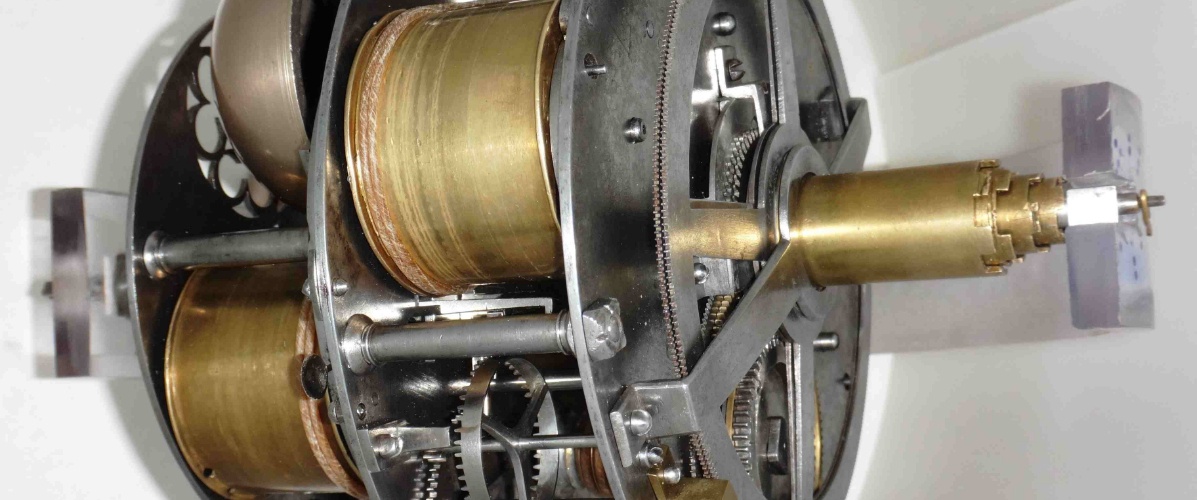Project for the Restoration of an Astronomical Clock with Celestial and Terrestrial Globes

Astronomical clock with celestial and terrestrial globes. Georg Roll, Johann Reingold, Augsburg, Germany. 1584.
Copper alloys, steel, silver, wood, enamel, glass, gilding. Diameter: 31.2 cm; height: 49 cm
This unique astronomical clock was made to a commission from Holy Roman Emperor Rudolf II as a particularly significant diplomatic gift. It incorporates the earliest examples of both terrestrial and celestial globes in Russia. Today six clocks of this kind are known to be in existence (in museums in Vienna, Dresden, London, Naples, Paris and St Petersburg) in varying states of preservation.
The upper, celestial, globe contains the clock mechanism that needs to be wound once a week. When the clock is running, the celestial globe rotates, showing the actual position of the constellations and the main stars in them, the Sun and the Moon. It can be used to determine the phases of the Moon, the times when heavenly bodies rise and set, their declination and right ascension or hour angle. The small dial at the upper end of the celestial globe (in the region of the Pole Star) shows the current time in hours and quarter-hours. Two little bronze bells sound the hours and the quarters. An automatic “perpetual” calendar on the horizontal rings provides the following information: the current year, month and date (according to both Gregorian and Julian calendars), the saint whose day it is and the sign of the zodiac. The calendar covers the period from 1584 to 1620.
The position of the lower, terrestrial globe can be set by hand from the time shown on the mechanical clock and shows the corresponding position of the Earth in space.
The base contains a magnetic compass and four sundials that can be used to determine real solar time in order to set and check the mechanical timepiece.

This device is probably the most complicated construction of its day, in terms of both mechanics and an understanding of the world. It superbly illustrates the Renaissance attitude to life – rational, bold and proud.
In essence, it presents the universe “from the Creator’s point of view”: the viewer is able to cast a glance over the whole visible part of the Cosmos, which is presented in inverted form. At the same time, the picture of the world is in constant motion in keeping with reality.
In the 16th and 17th centuries, much attention was devoted to astrology. All important decisions – the choice of a date for a wedding, the start of a war, a long journey or a difficult surgical operation – were taken on the basis of astrologers’ predictions. The information obtained from using the globe was used to draw up astrological forecasts and the owner of such a globe could manage without intermediaries. Astrological information was also considered important for experiments in the field of alchemy, of which Emperor Rudolf II was a keen devotee.
The device’s high quality of construction and rich artistic finish would have made it a desirable adornment for even the most luxurious room, stressing the intellectual and financial capabilities of its owner.
In the course of a programme for the restoration of the device, which was proposed by the late Vladimir Matveyev, the following work was carried out:
- a detailed study of the state of the device
- restoration of the mechanical part
- drawing up a kinematic diagram
- reconstruction and making good of the losses
- working out a plan for the exhibition of the globe that will explain its significance for history, philosophy and world view.
The aim of the project was a comprehensive restoration of the piece and the preparation of a museum presentation that will most fully reveal its potential.
The restoration was carried out by specialists from the State Hermitage’s Laboratory for Scientific Restoration of Timepieces and Musical Instruments: Mikhail Guryev, artist-restorer and head of the laboratory; Oleg Zinatullin, artist-restorer; and Valentin Molotkov, senior researcher.
The reconstruction of the wooden base was performed by Vladimir Gradov, an artist restorer who is head of the State Hermitage’s Laboratory for the Scientific Restoration of Furniture.
The keeper of the clock is Grigory Yastrebinsky, senior researcher in the State Hermitage’s Department of Russian Culture.
The project was carried out with the support of the company Samsung Electronics Rus.
